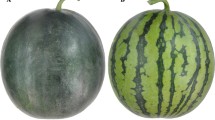Abstract
Flesh color of watermelon is an agronomically important trait that is predominantly determined by a network of the carotenoid biosynthetic pathway, which also contributes to the nutritional value of the fruit through the health-promoting function of carotenoids. We have identified a key gene, lycopene β-cyclase (LCYB) that may determine canary yellow and red flesh color of watermelon and developed a zero-distance molecular marker that identifies a critical single nucleotide polymorphism (SNP) that distinguishes different alleles of the LCYB gene. Analysis of the flesh color inheritance in segregating populations indicated that a single gene determines the color difference between canary yellow and red flesh in watermelon. The sequence comparison of full-length cDNA of LCYB, which was isolated using degenerate PCR and RACE, identified three SNPs in the coding region of LCYB between canary yellow and red. These SNPs showed perfect co-segregation with flesh color phenotypes. One of the SNPs introduces an amino acid replacement of evolutionarily conserved Phe226 to Val, which may impair the catalytic function of LCYB. This SNP was used to develop a cleaved amplified polymorphic sequence (CAPS) marker, which perfectly cosegregated with flesh color phenotype. Our results strongly suggest that LCYB may be the genetic determinant for canary yellow or red flesh color and our CAPS marker will allow breeders to economically distinguish between canary yellow and red watermelon fruit color at the seedling stage.





Similar content being viewed by others
References
Bramley PM (2002) Regulation of carotenoid formation during tomato fruit ripening and development. J Exp Bot 53(377):2107–2113
Davis AR, Levi A, Kim S, Hernandez A, King SR (2006) RNA extraction method from fruit tissue high in water and sugar. HortScience 41:1292–1294
Giuliano G, Aquilani R, Dharmapuri S (2000) Metabolic engineering of plant carotenoids. Trends Plant Sci 5:406–409
Henderson WR (1989) Inheritance of orange flesh color in watermelon. Cucur Genet Coop Rpt 12:59–63
Henderson WR, Scott GH, Wehner TC (1998) Interaction of flesh color genes in watermelon. J Heredity 89:50–53
Henikoff S, Henikoff JG, Alford WJ, Pietrokovski S (1995), Automated construction and graphical presentation of protein blocks from unaligned sequences. Gene 163:GC17–GC26
Hirschberg J (2001) Carotenoid biosynthesis in flowering plants. Curr Opin Plant Biol 4:210–218
Isaacson T, Ohad GI, Beyer P, Hirschberg J (2004) Analysis in vitro of the enzyme CRTISO establishes a poly-cis-carotenoid biosynthesis pathway in plants. Plant Physiol 136:4246–4255
Isaacson T, Ronen G, Zamir D, Hirschberg J (2002) Cloning of tangerine from tomato reveals a carotenoid isomerase essential for the production of β-carotene and xanthophylls in plants. The Plant Cell 14:333–342
Konieczny A, Ausubel FM (1993) A procedure for mapping Arabidopsis mutations using codominant ecotype-specific PCR-based markers. Plant J 4:403–410
Lewinsohn E, Sitrit Y, Bar E, Azulay Y, Meir A, Zamir D, Tadmor Y (2005) Carotenoid pigmentation affects the volatile composition of tomato and watermelon fruits, as revealed by comparative genetic analyses. J Agric Food Chem 53:3142–3148
Navot N, Sarfatti M, Zamir D (1990) Linkage relationships of genes affecting bitterness and flesh color in watermelon. J Heredity 81:161–165
Poole CF (1944) Genetics of cultivated cucurbits. J Heredity 35:122–128
Ronen G, Cohen M, Zamir D, Hirschberg J (1999) Regulation of carotenoid biosynthesis during tomato fruit development: expression of the gene for lycopene epsilon-cyclase is down-regulated during ripening and is elevated in the mutant Delta. The Plant J 17:341–351
Ronen G, Carmel-Goren L, Zamir D, Hirschberg J (2000) An alternative pathway to β-carotene formation in plant chromoplasts discovered by map-based cloning of Beta and old-gold color mutations in tomato. Proc Natl Acad Sci 97:11102–11107
Rose TM, Schultz ER, Henikoff JG, Pietrokovski S, McCallum CM, Henikoff S (1998) Consensus-degenerate hybrid oligonucleotide primers for amplification of distantly related sequences. Nucleic Acids Res 26:1628–1635
Tadmor Y, Katzir N, King S, Levi A, Davis A, Hirschberg J (2004) Fruit coloration in watermelon: lesson from the tomato. Proc Cucurbitaceae 2004, the 8th EUCARPIA Meeting on Cucurbit Genetics and Breeding. Olomouc, Czch Republic, pp 181–185
Thompson JD, Higgins DG, Gibson TJ (1994) CLUSTAL W: improving the sensitivity of progressive multiple sequence alignment through sequence weighting, positions-specific gap penalties and weight matrix choice. Nucleic Acids Res 22:4673–4680
Vincze T, Posfai J, Roberts RJ (2003) NEBcutter: a program to cleave DNA with restriction enzymes. Nucleic Acids Res 31:3688–3691
Acknowledgements
We thank Xingping Zhang, watermelon breeder for Syngenta, for providing plant materials for marker development. Appreciation is also extended to the members of the Vegetable & Fruit Improvement Center for their dedicated support of this research. This work was supported by the US Department of Agriculture grant (USDA CSREES #2004–34402–14768, “Designing Foods for Health”).
Author information
Authors and Affiliations
Corresponding author
Rights and permissions
About this article
Cite this article
Bang, H., Kim, S., Leskovar, D. et al. Development of a codominant CAPS marker for allelic selection between canary yellow and red watermelon based on SNP in lycopene β-cyclase (LCYB) gene. Mol Breeding 20, 63–72 (2007). https://doi.org/10.1007/s11032-006-9076-4
Received:
Accepted:
Published:
Issue Date:
DOI: https://doi.org/10.1007/s11032-006-9076-4




